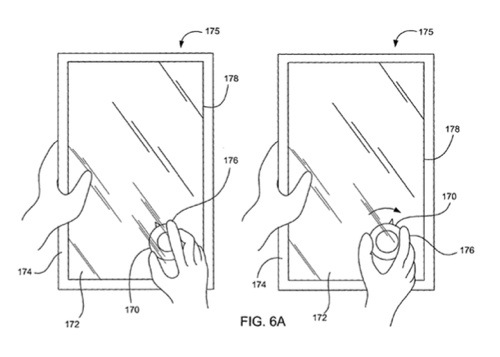A patent (number 8,239,784) for “mode-based graphical user interfaces for touch sensitive input devices” shows Apple is working on an alternative input method for iOS devices.
A user interface method is disclosed. The method includes detecting a touch and then determining a user interface mode when a touch is detected. The method further includes activating one or more GUI elements based on the user interface mode and in response to the detected touch.
Here’s Apple’s summary of the invention: “The invention pertains to gestures and methods of implementing gestures with touch sensitive devices. Examples of touch sensitive devices include touch screens and touch pads. The invention also pertains to user interfaces and methods of implementing user interfaces with displays.
The invention can be implemented in numerous ways, including as a method, graphical user interface, computing device, or a computer readable medium. Several embodiments of the invention are discussed below.
The invention relates, in one embodiment, to a user interface method. The method includes detecting a touch. The method also includes determining a user interface mode when a touch is detected. The method further includes activating one or more GUI elements based on the user interface mode and in response to the detected touch.
“The invention relates, in one embodiment, to a user interface method. The method includes displaying a group of media items. The method also includes detecting a touch over the group of media items that are displayed. The method further includes activating a virtual scroll wheel when a touch is detected over the displayed media items.
“The activation of the virtual scroll wheel includes displaying and enabling the functionality of the virtual scroll wheel, the virtual scroll wheel providing a touch region where a user swirls their finger in order to traverse through the group of media items. The method additionally includes determining if a touch event is performed relative to the touch region of the virtual scroll wheel. Moreover, the method includes scrolling through the group of media items when a scrolling touch event is performed.
“The invention relates, in one embodiment, to a method performed on a user operated electronic device having a display and a touch screen. The method includes determining if a touch is detected. The method also includes monitoring and analyzing the current operating conditions when a touch is detected. The method also includes activating a first GUI element for a first set of operating conditions. The method additionally includes activating a second GUI element for a second set of operating conditions.
The invention relates, in one embodiment, to a method performed on a computing device having a display and a touch sensing input device. The method includes sensing touches. The method also includes displaying and enabling a GUI element when a touch is detected. The GUI element is based on at least one of the following: (a) the application currently running on the computing device; (b) the current state of the application; and/or (c) one or more characteristics of the touch. The characteristics include, for example, touch location, touch ID, number of touches, and touch motion. The method further includes disabling and removing the GUI element from display when one of the following events occurs: (a) the touch is no longer detected, (b) a touch has not been detected for a preset amount of time, (c) a certain amount of time has gone by since the step of displaying and enabling, (d) a user selection.
“The invention relates, in another embodiment, to a computing system. The computing system includes a display device configured to display a graphical user interface. The system also includes a touch screen positioned over the display device. The touch screen is configured to detect touches that occur over the display device. The system further includes a processor operatively coupled to the display device and the touch screen. The processor instructs the display device to display one or more GUI elements in response to a touch, and performs actions associated with the GUI element when touch events are detected relative to the displayed GUI elements.
“The invention relates, in another embodiment, to a computing device. The computing device includes a processor. The computing device also includes a touch screen capable of sensing touch events. The computing device further includes a display configured to simultaneously display a plurality of media items and a virtual scroll wheel. The virtual scroll wheel provides a region where touch events are performed in order to implement a scrolling action. The scrolling action allows a user to traverse through the plurality of media items.”
The inventors are Steve Hotelling, Brian Q. Huppi, Joshua A. Strickton, Duncan Robert Kerr, Bas Ording, Imran Chaudhri, Greg Christie and Jonathan P. Ive.


